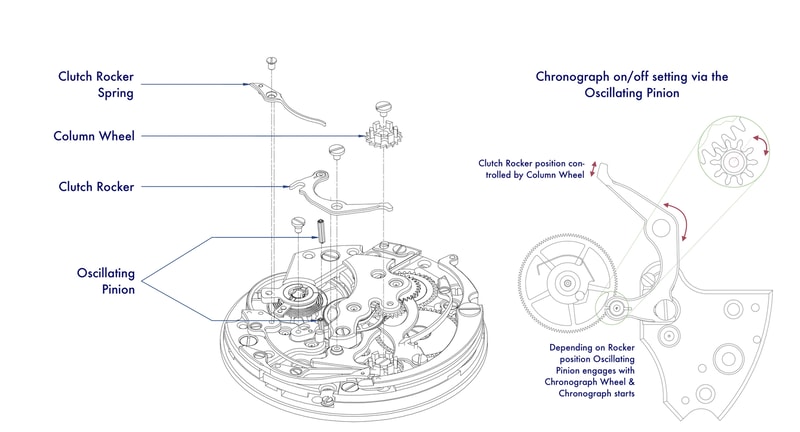While the AgenGraphe represents a significant turning point for chronographs this millennium, there is another chronograph movement that represents some of the best of watchmaking at the end of the last millennium.
We’re talking, of course, about the THA/ LJP 5000 monopusher which underpins our 37.04 series of chronographs and is celebrated for being the fruit of the collaborative labours of some of the most celebrated watchmakers today.
Created in the late-80’s/ early-90’s, the LJP 5000 is a far more classical chronograph than the AgenGraphe. It is built using traditional ingredients like a column wheel, a horizontal clutch, and even a relatively slow pace of 21,600 vph. What really sets it apart in a modern context is its size: at a diameter of 24.60mm and a thickness of only 4.20mm, it occupies 58% less volume than the AgenGraphe. Remarkable when you think about the production limitations and the amount of mechanical complexity.

The dimensions of the movement were by no means accidental, but rather grounded in the reality of watchmaking in an era when commercial and production realities were significantly different to today.
The LJP 5000 started life as an ebauche developed by a company called Techniques Horlogères Appliquées (THA) in Sainte-Croix. THA also happened to be where three young and ambitious watchmakers were earning their stripes: Vianney Halter, Denis Flageollet, and Francois-Paul Journe. These names don’t require any further introduction today, but it does paint an interesting mental picture to think of all three labouring over this movement.
THA had been commissioned to develop a small chronograph suitable for tortue-shaped watches and with a very specific and limiting diameter and thickness requirement. And like most great stories, the challenge didn’t stop there. All of this also had to be achieved in far too little time and not that many dollars (or francs rather). It seems masochism is a shared trait among all watchmakers and creatives.
The young team at THA decided against a de novo approach and instead based their construction on a tried and tested movement that met the dimensional constraints: the Peseux 7001 (which we’ve also used to great effect in our 27.01 and 27.02).
Compactness was satisfied thanks to a 23.30mm diameter, and the 7001’s long history and application in watchmaking meant that its technical abilities - primarily the available torque - was well known and verified. Our three intrepid watchmakers were off to a good start…
Their next immediate challenge - finding sufficient space for a complete chronograph mechanism.
Their solution? An oscillating pinion.

The oscillating pinion replaces the coupling wheel found in conventional chronographs and saves space in three distinct ways:
- The pinion’s diameter barely exceeds that of a conventional axis and hence would fit neatly into the Peseux 7001’s gear train (in contrast to a coupling wheel)
- It pivots only on one of its ends, removing the need for a mobile support on the other end; and
- There is additional space available around the pinion that can be used.

THA made good use of all three benefits of the oscillating pinion principle and managed to construct a monopusher chronograph that was only 1.3mm larger than the base movement! With all its charm, elegance, and clever engineering, it’s easy to see why this movement has a cult following.
Fast forward a couple of decades, and we, at MING, found ourselves with access to a new-old-stock batch of these movements - now known as the LJP 5000, after La Joux-Perret acquired the rights to this movement. As collectors ourselves, and with the ideas MT had for it, there was no way we could pass up this incredible opportunity.
In addition to refurbishing the movements, MT also reworked the bridges to update the movement to fit the MING design language. Our version of the LJP has some skeletonised bridges, is treated to a 5N rose gold finish, and features our signature barrel wheel design.

The LJP 5000 has been central to celebrating our 5th anniversary - a major milestone for us - in the form of the 37.04 Titanium and the 37.04 Tantalum (which is also our first ever tantalum watch).
As perhaps the ultimate variant to complement the movement, we created the 37.04 Rose Gold with a 18k Rose Gold case and matching gold dial with guilloche – a ‘golden pebble’!
– Dr. B.
Author’s note: I would like to thank Denis Flageollet for valuable input.
Photo credits: Dr. Magnus Bosse
Published: 17th October 2024





